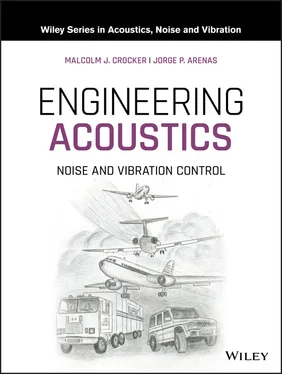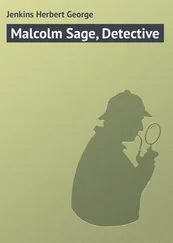Because they cover important topics, Chapters 8, 10, 12, and 13have received expanded treatment in this book. Contracts and grants received by the first author enabled him to conduct research on sound intensity in which he conceived the first use of sound intensity measurements in determining the transmission loss of partitions. During this period, he chaired the ANSI SI‐12 committee which produced the first ever standard, S12‐12‐1992, Engineering Method for the Determination of the Sound Power Levels of Noise Sources Using Sound Intensity. Some of the research results are summarized in Chapter 8.
The first author received a nine‐year contract from a company which produced over 80% of the new mufflers for automobiles manufactured in the USA in the 1960s and 1970s. During this research, he together with a graduate student, C.‐I. J. Young, produced the first acoustical finite element model to predict muffler noise attenuation. This, together with research on measuring source impedance of engines and prediction of the transmission loss of concentric tube resonators with J.W. Sullivan, resulted in improved modeling of the acoustics of exhaust systems. These research results are included in Chapter 10. Intense noise was caused by the Saturn V moon rocket at launch. During the 1960s there was great concern about the vibration and potential for fatigue during the launch of the Saturn V vehicle. First during a 1966–1997 short course – Program for Advanced Study – and then through personal contacts and communications with Richard H. Lyon, the first author began studies on SEA. He and a colleague produced the first papers demonstrating the usefulness of SEA in predicting the transmission of sound through single and double partitions. These results and others are included in Section 12.5 of Chapter 12. The first author also received several research contracts from ASHRAE, AMCA, and ARI to study the acoustics of air‐conditioning systems. These studies resulted in a new in‐duct method of measuring the sound power of fans. During this period, the first author served as chair of the ASHRAE Technical Committee 2.6 Sound and Vibration. This experience and background information has been included in Chapter 13in addition to some text and figures from an earlier chapter written for CRC Press by A.J. Price and M.J. Crocker.
Chapter 8reviews the use of sound intensity measurements to determine the sound power of machinery, noise source identification, and the transmission loss of partitions. Accurate sound intensity measurements only became possible with the development of two‐channel mini‐computers, the fast‐Fourier transform and the sound intensity algorithms. The use of sound intensity measurements allows the accurate determination of the sound power of machinery in situ even in the presence of extremely noisy ambient conditions. Sound intensity measurement s can also be used to determine the transmission loss of walls without the need for a reception room. In addition, such measurements allow the transmission loss of different parts of a wall partition to be determined, which the conventional two‐room method does not.
Chapter 10deals with reactive and passive mufflers and silencers. Reactive mufflers are used on all automobiles and trucks, and proper acoustical design is of course most important. Although useful theory and measurements date back to the 1950s, it was not until finite element modeling was first used in 1971 on non‐concentric reactive mufflers that the attenuation of such mufflers could be predicted accurately. This chapter also reviews and compares different attempts to predict the attenuation of passive mufflers used in industrial systems.
Chapter 12discusses various aspects of sound and vibration in buildings. An important aspect of building acoustics is the unwanted transmission of sound from one room to an adjoining one. One measure of the effectiveness of a party wall to reduce this transmission is the sound reduction index, commonly called the transmission loss (TL). This chapter presents different theoretical models for TL and also measurements of TL for a wide variety of wall structures. A useful theoretical approach to determine the TL of single and multiple layer walls is statistical energy analysis (SEA), as described in Section 12.5 of Chapter 12.
Chapter 13deals with the noise and vibration generated by air‐conditioning (HVAC) systems in buildings. Although such systems are widely used they are often inadequately or incorrectly designed acoustically. Correct design at the beginning often costs a little more, but corrections made to such systems later, after they are installed, can be very expensive.
Malcolm J. CrockerJorge P. Arenas
30 September 2020
The authors are greatly indebted to many colleagues for their patience and considerable support with this project. The staff at John Wiley including Paul Petralia, Eric Willner, Anne Hunt, Lauren Poplawski, Becky Cowan and Karthika Sridharan have been most helpful. We were also supported by Margarita Maksotskaya at Auburn University, who provided splendid assistance in bringing this book project to a successful conclusion. Our colleagues are thanked for reading the book in manuscript. Pouria Oliazadeh read every chapter and provided helpful comments throughout. In addition, Gene Chung, Steven Hambric, Colin Hansen, David Herrin, Reginald Keith, Robin Langley, Florent Masson and Tomas Ulrich, kindly acted as reviewers of selected chapters with which they had expertise. The first author is grateful for the support of Richard H. Lyon, a brilliant acoustician and one of the originators and developers of SEA. The first author learned so much about the subject from him. Richard Lyon almost was an unofficial advisor for the first author's PhD dissertation and section 12.5 of Chapter 12is dedicated to Dr. Lyon's memory. Last and not least, the authors thank their wives, Ruth Crocker and Ester Arteaga for their support, patience and understanding during the lengthy period of preparation of this book.
1 Introduction
1.1 Introduction
Real‐world problems in the control of noise and vibration in aircraft, appliances, buildings, industry, and vehicles require the measurement of particular environmental parameters such as sound pressure, force, acceleration, velocity, displacement, etc. This process is often performed by using acoustical and vibration transducers. Vibration and acoustical sensors are transducers which convert a measured physical property (e.g. the vibration of a body or the propagation of a sound wave) into an electrical signal (voltage or charge). These electrical signals are often conditioned to provide signals suitable for the measurement devices. The signals are then amplified, attenuated, or transformed so that they can subsequently be analyzed and/or processed to provide the data of particular interest in the time domain and frequency domain. The information provided by these analyses is widely used to assess sources of noise and vibration, and design proper engineering control measures. For some cases, such as simple measurements of the A‐weighted sound pressure level, only limited amounts of processing are needed. In other cases with more sophisticated measurements, special analysis and processing is required. Such examples include modal analysis, sound intensity, wavelet analysis, machinery condition monitoring, beamforming, and acoustical holography, with which quite complicated signal analysis and processing may be needed. Some years ago, almost all measurements were made with analog equipment. Many analog instruments are still in use around the world. However, by using analog‐to‐digital conversion, increasing use is now made of digital signal processing to extract the required data. This is done either in dedicated instruments or by transferring measurement results onto computers for later processing by software.
Читать дальше












